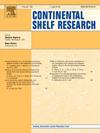Radionuclides and heavy metals in surface sediments of the Bering and Chukchi Seas: distribution, source identification, and risk assessment
IF 2.2
3区 地球科学
Q2 OCEANOGRAPHY
引用次数: 0
Abstract
The Arctic region can no longer be considered a pristine environment, and radioactive and heavy metal pollution have become a growing concern. The present study was conducted to investigate the distributions, sources, and risk assessments of radionuclides and heavy metals in surface sediments from the Bering and Chukchi Seas. The mean activities of 40K, 137Cs, 228Th, 226Ra, 228Ra, 238U, and 210Pb in sediments were 446, 0.97, 24.2, 27.6, 22.2, 23.6, and 72.8 Bq/kg, respectively. Radiological hazard indices suggested that the sediments did not pose a significant radiological risk to humans. The mean Cu, Pb, Cd, Cr, and Zn contents were 18.4, 14.1, 0.231, 47.2, and 88.7 μg/g, respectively. The geoaccumulation and pollution load indices demonstrated that heavy metal accumulation (Cu, Pb, Cd, and Zn) existed at some sites of the study area. Multivariate statistical analyses suggested that Cu, Pb, Cr, and Zn likely originated from natural sources, while Cd was derived from both natural processes and fossil fuel burning.
白令海和楚科奇海表层沉积物中的放射性核素和重金属:分布、来源鉴定和风险评估
北极地区已不再是一个原始的环境,放射性和重金属污染日益成为人们关注的问题。本研究旨在调查白令海和楚科奇海表层沉积物中放射性核素和重金属的分布、来源和风险评估。沉积物中40K、137Cs、228Th、226Ra、228Ra、238U和210Pb的平均活度分别为446、0.97、24.2、27.6、22.2、23.6和72.8 Bq/kg。放射性危害指数表明,沉积物对人体不构成显著的放射性危害。Cu、Pb、Cd、Cr和Zn的平均含量分别为18.4、14.1、0.231、47.2和88.7 μg/g。地质累积和污染负荷指数表明,研究区部分站点存在重金属(Cu、Pb、Cd和Zn)累积。多变量统计分析表明,Cu、Pb、Cr和Zn可能来自自然来源,而Cd可能来自自然过程和化石燃料燃烧。
本文章由计算机程序翻译,如有差异,请以英文原文为准。
求助全文
约1分钟内获得全文
求助全文
来源期刊

Continental Shelf Research
地学-海洋学
CiteScore
4.30
自引率
4.30%
发文量
136
审稿时长
6.1 months
期刊介绍:
Continental Shelf Research publishes articles dealing with the biological, chemical, geological and physical oceanography of the shallow marine environment, from coastal and estuarine waters out to the shelf break. The continental shelf is a critical environment within the land-ocean continuum, and many processes, functions and problems in the continental shelf are driven by terrestrial inputs transported through the rivers and estuaries to the coastal and continental shelf areas. Manuscripts that deal with these topics must make a clear link to the continental shelf. Examples of research areas include:
Physical sedimentology and geomorphology
Geochemistry of the coastal ocean (inorganic and organic)
Marine environment and anthropogenic effects
Interaction of physical dynamics with natural and manmade shoreline features
Benthic, phytoplankton and zooplankton ecology
Coastal water and sediment quality, and ecosystem health
Benthic-pelagic coupling (physical and biogeochemical)
Interactions between physical dynamics (waves, currents, mixing, etc.) and biogeochemical cycles
Estuarine, coastal and shelf sea modelling and process studies.
 求助内容:
求助内容: 应助结果提醒方式:
应助结果提醒方式:


